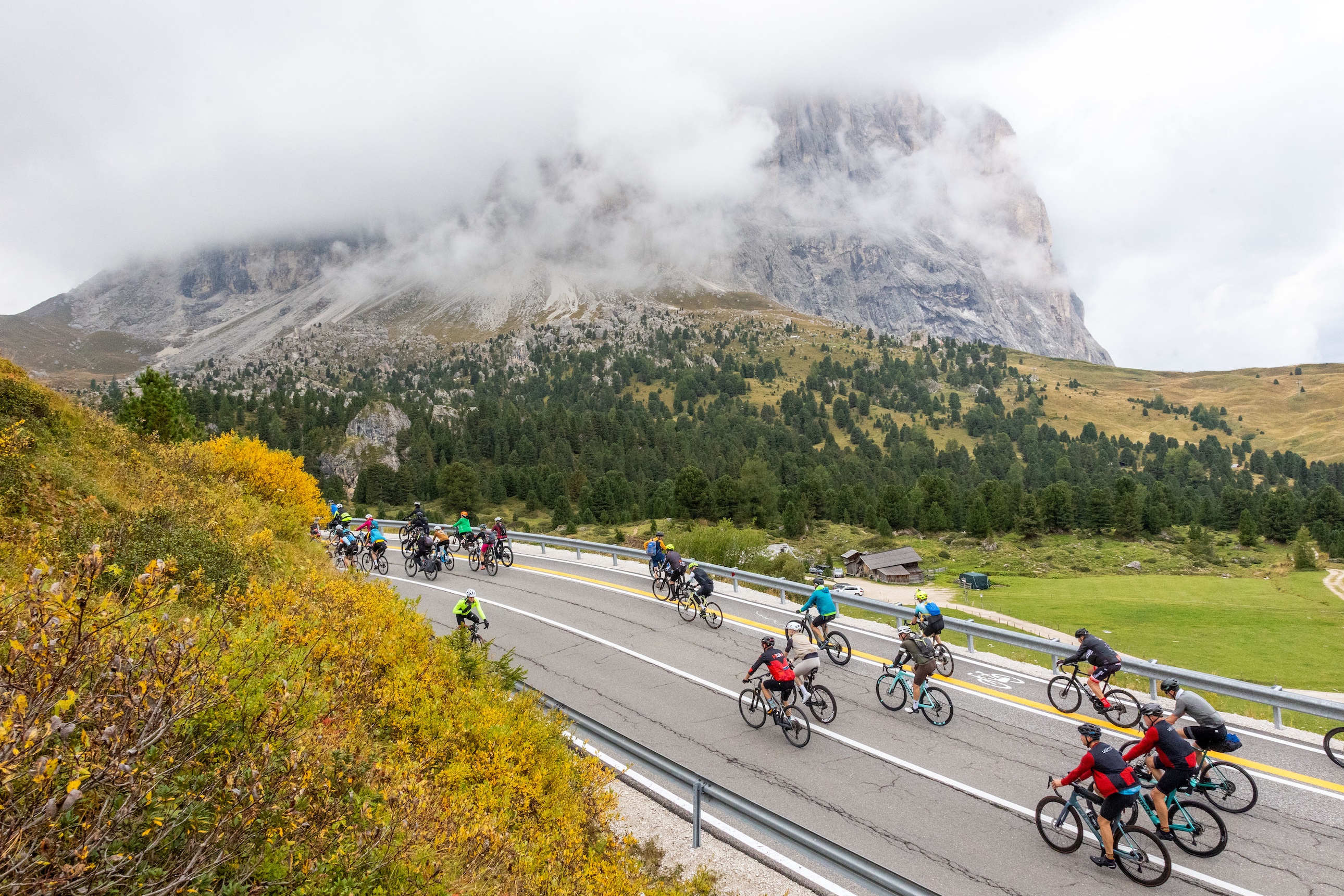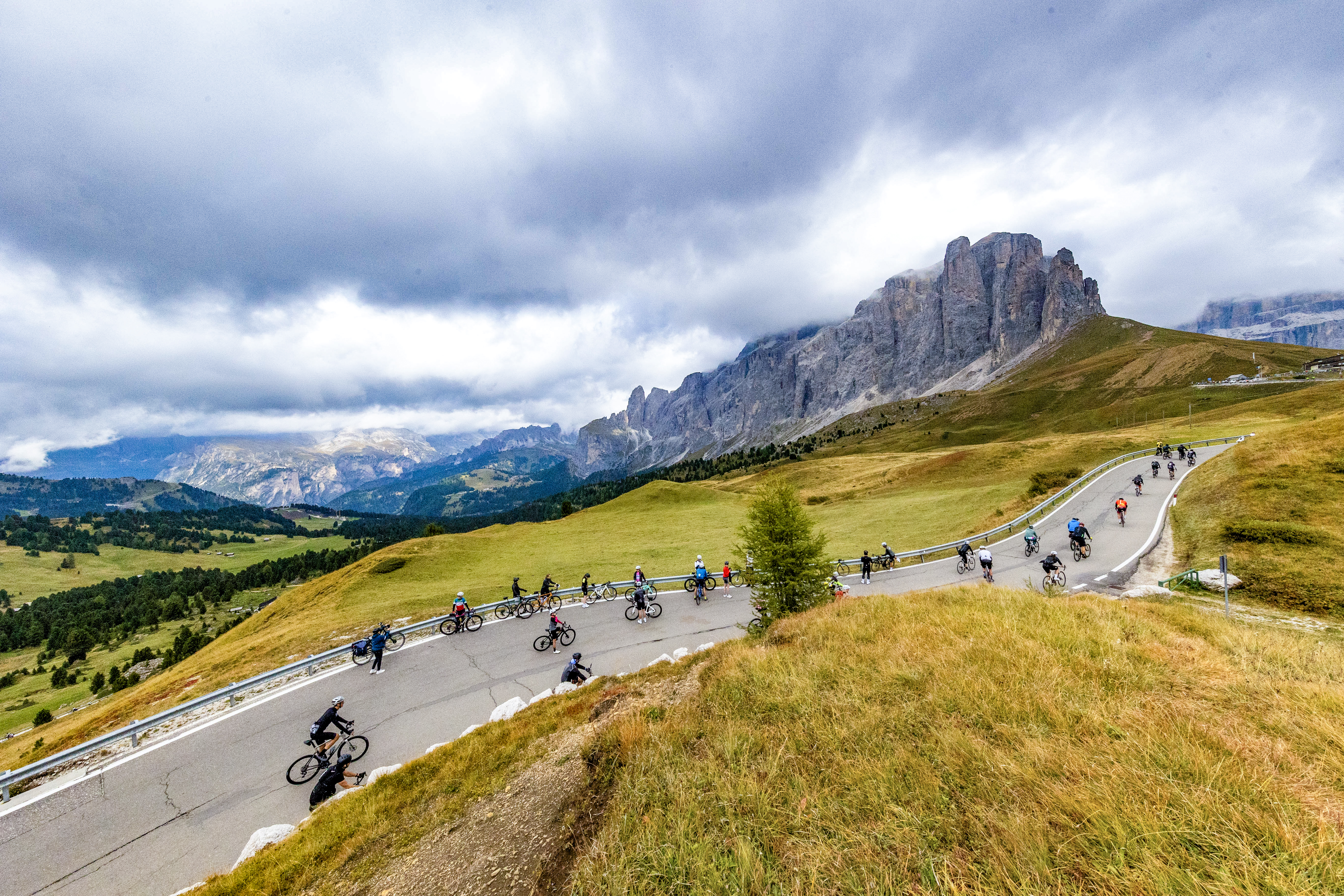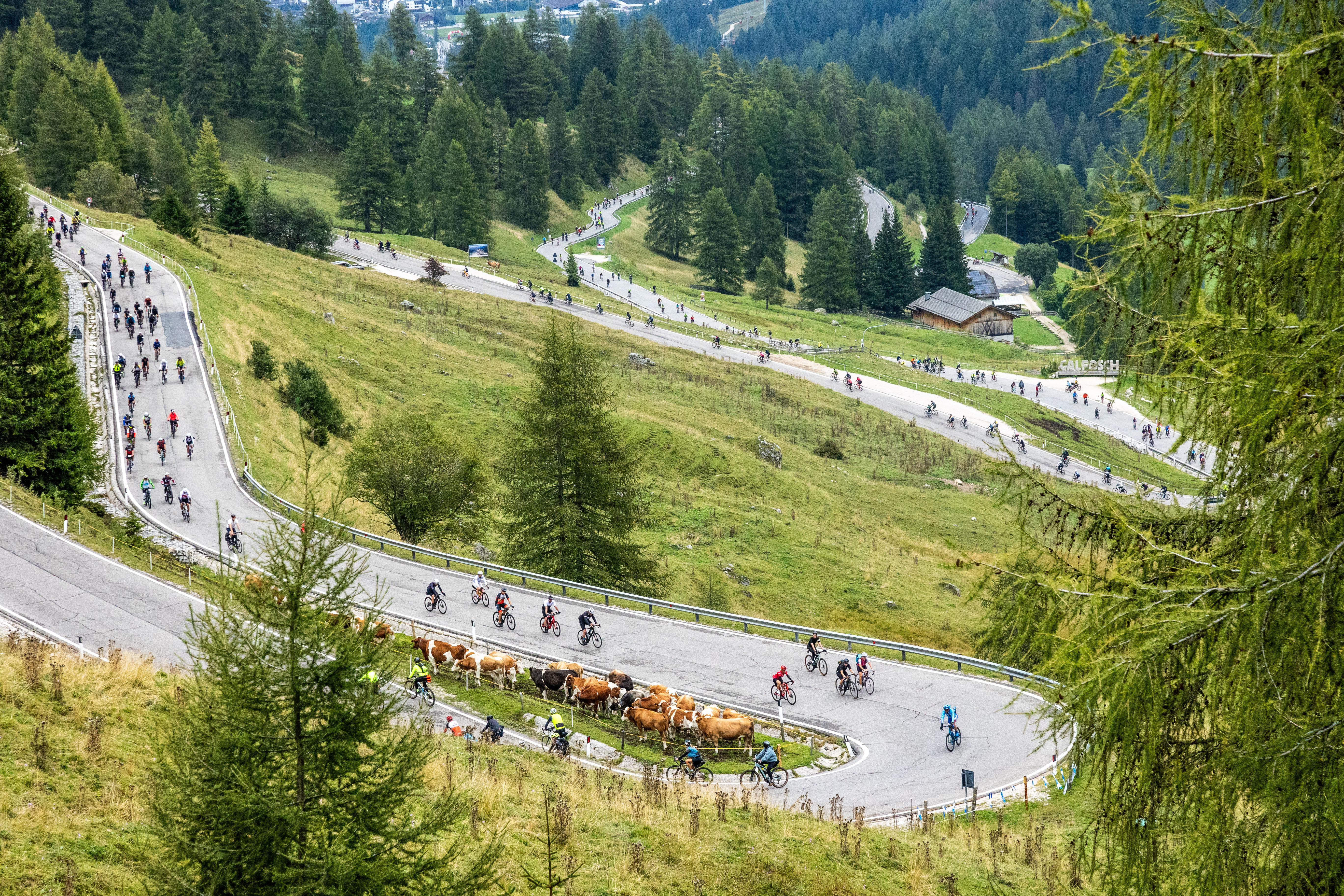There are two kinds of rider: those who enjoy the scenery, and those who prefer staring at their stems. If I’ve taken the trouble to fly to a stunning part of the world, I want to be looking around, not glaring at my Garmin. Thankfully, at the Sellaronda Bike Day in in the Dolomites in Northern Italy, there’s no temptation to fixate on numbers – because the normal metrics of bike riding don’t apply.
Twice a year, cyclists get the chance to ride arguably the most beautiful route in the world on traffic-free roads. There are no medals awarded at the end. There’s not even a finish line. Speed, distance and suffering count for nothing. Instead, it’s all about smiles, sights and pleasure – as well as beer, bacon sandwiches and apple strudel.
The Sellaronda is essentially a sportive, but unlike any other. Firstly, all of the roads it uses are closed, not just some of them for a few hours, but all of them, from 8:30am to 4pm. Secondly, there’s no pre-dawn start with thousands of riders squeezed into grids. You can start at any time you want, from anywhere on the route. Thirdly, it’s entirely free. No registration, no fee, no doctor’s certificate required.
And then there’s the route: a 52km loop around the spectacular Gruppo del Sella mountain massif in the heart of the Italian Dolomites, a range of soaring shark’s teeth that has been designated a UNESCO World Heritage Site. If you’ve never been before, think of the Dolomites as Radiohead to the Alps’ Oasis or the Pyrenees’ Coldplay – the connoisseur’s choice, never quite mainstream.
(Image credit: Freddy Planinschek)
The loop takes riders over four mountain passes, three of them over 2,000m high. All are regulars in the Giro d’Italia, with one of them, the Passo Pordoi (2,239m), featuring 14 times as the Cima Coppi, or highest point of the race. The route accumulates 1,650m of elevation, with gradients on each of the climbs averaging 7-8%. To reiterate, though: it’s not about the metrics.
“I’m one of the estimated 10,000 riders taking part in the event”
Besides, it’s not as if you’re wearing a bib number or a timing chip. I’m one of an estimated 10,000 riders taking part in the September event. That might sound like a lot, but remember, all those riders are beginning at different times and locations, so the route never feels as crowded as the start of the more famous Maratona dles Dolomites, which sees 9,000 riders race on these same roads every July.
All riders welcome
Nine years ago, when I first rode the event, I witnessed local hotelier and sustainable transport advocate Michil Costa summit the first pass on his lovingly preserved, 120-year-old penny-farthing. Costa is a well-respected personality in these parts, though the dream he shared with me then – to make every day a Sellaronda Bike Day – is still to be fulfilled.
This year, there is no shortage of other ‘local characters’ kitted out in full retro ensemble of woollen jerseys, toe clips and down-tube shifters. And I’m losing count of the number of riders pushing flat pedals in trainers. Bike snobs need not apply.
I start from my hotel in Corvara, the largest of the four ‘hub villages’ that provide access to the route. Most participants drive to these villages, park up their cars and start riding as and when they’re ready. From Corvara, the steepest part of the route is at the start of the first climb, to the Passo Gardena. This bisects the village of Colfosco. During its first few years, the route had operated in the opposite direction, but Colfosco residents complained that the fast descent through their village made it dangerous for them to cross the road. The route has been reversed ever since.

(Image credit: Freddy Planinschek)
At 9km, the Passo Gardena is the longest climb of the day. The summit arrives at the end of a squiggle of hairpins that offer progressively stunning views back down the valley. At the top I have to weave through all the riders who have stopped for refreshments from the pop-up bars selling beers (€4), espresso (€2.50), speck or formaggio panini (€5) and apple strudel (€5).
This isn’t a race, remember. The descent from here is fairly gradual, allowing me to savour the views of the massive wall of rock to my left and the pink-tinged bulk of Sassolungo straight ahead.
At the bottom of the descent a junction marks the start of the next climb. It’s also where riders join and leave the route, so bottlenecks are inevitable. I start braking when I see the ‘junction ahead’ sign and am just about able to thread my way through the throng and start the next climb without unclipping.
This clustering of riders is a hazard at the tops and bottoms of each of the four climbs, such is the social, non-competitive nature of the event – and I never see any collisions or hear any angry voices. Another potentially more serious hazard is the occasional rider who, for reasons best known to themselves, chooses to ride the route in the wrong direction. I count more than a dozen during the four hours I’m on the road, so it pays to have your wits about you.
Coppi’s nemesis
The next climb delivers me to the highest point of the route, the 2,241m-tall Passo Sella, which a 20-year-old Fausto Coppi had to be pushed up to by his team-mate Gino Bartali during the 1940 Giro after suddenly cracking – though he recovered enough to win the first of his five Giros.
The descent twists through great corridors of rock. Groups of riders stop at each curve and take photographs of what is the most spectacular stretch of the route. Many riders are on e-bikes, and fragile egos may not cope with being regularly overtaken by them, especially the one towing a trailer containing his dog, but it doesn’t bother me. Need I say it again: this isn’t a race. Why rush it?

You don’t need to look down at your power numbers when confronted with scenes like this
(Image credit: Freddy Planinschek)
What goes up…
The next climb is the Pordoi, known as Coppi’s mountain – he was first over it almost every time he raced up it. His statue is at the top, but amid the melee of riders, I can’t find it. Never mind, the most exciting part of the day is to come: the 9.4km descent to Arabba. Long, fast, heart-stopping straights are followed by stomach-flipping hairpins.
It’s a chance to unleash our inner Tom Pidcock and to exact sweet revenge on all those e-bikes. The final climb to the Passo Campolongo is the shortest, at just 4km, but the plunge down the other side into Corvara is no less rewarding for that. In the shadow of the Dolomites’ most distinctive peak, the Sassongher, the road corkscrews through pastures of huge Alpine cattle, their cowbells providing a ghostly soundtrack.
Back at my hotel, it seems against the spirit of the event to check my ride data, so I turn off my headset. I don’t need any third-party metrics to tell me how good I’m feeling. Many of the region’s hotel owners were sceptical when the idea for the Sellaronda Bike Day was first mooted more than 20 years ago.
They were concerned that what was designed to attract some of the 30,000 riders who failed to get a place in the Maratona each year might put off their non-cycling guests. That has turned out to be emphatically not the case. My wife is a perfect example. While I’m riding, and despite the road closures, she is able to take a cable car from the centre of Corvara to the heart of the mountains and enjoy an easy walk along well-marked paths between rifugios serving food and drink. Reunited at the hotel, we compare our Strava files over dinner – but agree on one thing: conventional metrics just can’t do justice to the rugged beauty of the Dolomites.

Whether you’re riding up or down, roads like this are pure joy for a cyclist
(Image credit: Freddy Planinschek)
Essential travel information
How to get there: The nearest international airports are Venice in Italy and Innsbruck in Austria. Public transport options from either are limited, so you will need to book transfers, taking around 2hr 30min from Venice or 2hr from Innsbruck. The cheapest option is to go through a collective transfer company such as clevertransfer.eu – €138 per person plus €25 per bike each way from Innsbruck, and €198 per person plus €25 per bike each way from Venice. Alternatively, from Venice you could book the Cortina Express bus (cortinaexpress.it) to Cortina d’Ampezzo (€25 per person and €25 per bike each way), and then a taxi from Cortina for approximately €150.
Bike hire: There are bike rental places in most of the villages along the route. Search “bike rental” at altabadia.org.
Eating and drinking: You can cycle or take a taxi the 10km to Ciasa Urban, which celebrates the local Ladin cuisine. Served on a terrace overlooking the mountains, a five-course set menu of traditional dishes, including barley soup, homemade ravioli and pork knuckle, costs €75 per person, including drinks: ciasaurban.it. We also enjoyed lunch in the beautiful Rifugio Alpino Pralongia (pralongia.it), a former mountain hut that has been turned into a hotel and restaurant. You reach it by cable car from Corvara, then an easy 90-minute hike across the Pralongia plateau, which offers 360º panoramas of the Dolomites.
Where to stay: We stayed at the Hotel Marmolada in the centre of Corvara. It offers spacious rooms with balconies, a good-sized indoor swimming pool, sauna, steam baths, secure bike storage and cleaning area, and a gourmet restaurant. Doubles from around €300 per night: marmolada.org.
Bike events: Next year’s 20th anniversary Sellaronda Bike Days (sellarondabikeday.com) take place on Saturday 6 June and Saturday 12 September. It’s free to enter, and there are first-aid and mechanics’ stations if either you or your bike needs attention. Another free cycling event on closed roads is Dolomites Bike Day on Saturday 20 June. Meanwhile, if you want something more competitive, the Maratona dles Dolomites takes place on Sunday 5 July and costs €166 to enter.
Cycling Weekly travelled as guests of Alta Badia Tourism: altabadia.org
Owing to a production error, an incomplete version of this feature appeared in the 9th October 2025 print edition of Cycling Weekly. The full article is published here in its entirety. We apologise for the mistake.
